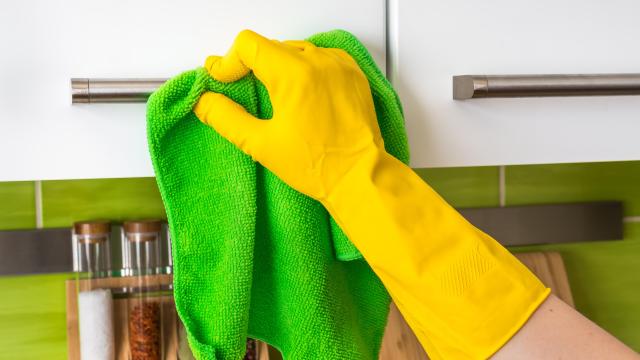Even if you keep your kitchen relatively clean—wiping down countertops and tables, vacuuming the floor, and keeping the sink area as tidy as possible—grease and grime from regular cooking is going to build up over time. This is especially the case when it comes to surfaces we don’t wipe down on a regular basis, like the walls, backsplash, and cabinets.
Of these, cabinets are the hardest to keep clean: They’re high-touch surfaces, often in the path of cooking vapors from the stove, and have another space to clean inside. If it’s been a while since you deep cleaned your kitchen cabinets, here’s what to do.
Start with the inside of the cabinets
You can skip ahead to the next section if you’re only interested in cleaning the exterior of the cabinets, but chances are, the insides are pretty gross too.
Here’s where to start:
- Empty the contents of the cabinets.
- Use a crevice tool attachment to vacuum the inside of the cabinet, getting into the corners to get all the dust and crumbs.
- Assess the condition of your contact paper or other type of shelf liner to see if it needs to be replaced. If so, peel it off, so you shelves are empty and bare.
Because kitchen cabinets hold food and the plates, dishes, and cups we eat and drink from, it’s best to avoid harsh chemicals when cleaning the inside.
To make a DIY solution that’s both safe and effective, mix a 50:50 solution of white vinegar and warm water in a clean spray bottle, add a few drops of liquid dishwashing detergent, then gently shake to combine the ingredients.
Next, lightly spritz the inside of the cabinet with the solution—making sure not to oversaturate any of the surfaces—and wipe them down with a clean rag or cloth. Finally, take a new clean cloth or sponge, dampen it with warm water, and wipe down the surfaces again to get rid of any residue.
In addition to the actual shelves, don’t forget to clean the inside of the cabinet door, and the top, back, and sides of the cabinet’s interior.
The cabinet has to dry before moving forward, so using as little of the solution as possible to get the job done will make everything move faster.
Clean the exterior
While the insides of the cabinets are drying out, it’s time to tackle the outsides. Start by using the same solution described above, but this time, let it sit on the cabinets for a minute or two before wiping. You may need to use a soft-bristled toothbrush to work on particularly grimy areas (typically the spots that are touched when the cabinets are opened and closed).
If that doesn’t do the trick, take some baking soda (you can start with 1/2 cup) and mix in a mild liquid dishwashing detergent (like Dawn) until it turns into a paste. Then use a cloth or toothbrush to apply it to the grimiest areas, and rinse with a clean dampened rag or sponge.
Don’t forget to clean the cabinet’s hardware and any other features, like glass panes on the doors.
Finish the interior
Once the insides are clean and dry, it’s time to line the shelves (unless the lining you had before is still in good shape). In addition to contact paper and dedicated shelf liner, some of the other materials you can use to line your shelves include:
- Self-adhesive laminate floor tiles
- Leftover linoleum floor pieces
- Leftover wallpaper pieces
- Plastic canvas
- Laminated paper
- Wax paper
When you’re finished lining, it’s time to reload the cabinets. If you’ve been thinking of implementing some type of organizational system, now’s the time to do it.
Either way, assess each item before putting it back in the cabinet: Does it need to be washed? Is it something you still use? Is it something you rarely use, and could put on a higher shelf? Is the shelf-stable food past its expiration date? If it doesn’t belong in there, leave it out.

Leave a Reply
You must be logged in to post a comment.